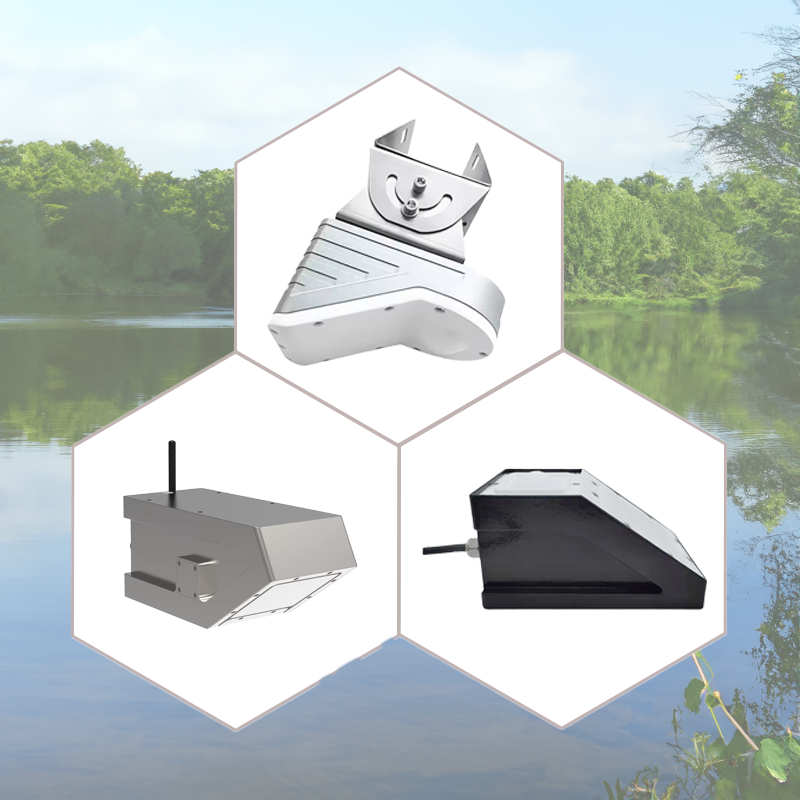Introduction
With the advancement of smart agriculture, precise hydrological monitoring has become a key technology for improving irrigation efficiency, flood control, and drought resistance. Traditional hydrological monitoring systems typically require multiple standalone sensors to measure water level, flow velocity, and discharge separately. However, radar-based integrated flow-level-velocity hydrological sensors (hereafter referred to as “integrated sensors”) combine these functions into a single, non-contact, high-precision device, demonstrating significant value in agricultural applications.
1. Working Principle and Technical Advantages of Integrated Sensors
(1) Working Principle
- Radar Water Level Measurement: High-frequency electromagnetic waves are emitted, and the reflected signal is analyzed to determine water level.
- Radar Flow Velocity Measurement: The Doppler effect is used to calculate water velocity by analyzing frequency shifts in reflected waves.
- Discharge Calculation: Combines water level, velocity, and channel cross-section data to compute real-time flow rate.
(2) Technical Advantages
✔ Non-contact Measurement: Unaffected by water quality, sediment, or floating debris, making it ideal for complex agricultural water environments.
✔ High Accuracy and Stability: Millimeter-level water level precision, with a wide velocity measurement range (0.1–20 m/s).
✔ All-Weather Operation: Functions reliably under rain, snow, or varying light conditions, suitable for long-term field monitoring.
✔ Low Power Consumption & Wireless Transmission: Supports solar power and real-time cloud data upload.
2. Key Applications in Agriculture
(1) Precision Irrigation Management
- Implementation: Installed in irrigation channels or field drainage ditches to monitor water level and flow in real time.
- Benefits:
- Dynamically adjusts irrigation based on crop water demand, reducing waste (water savings of 20%–30%).
- Integrates with soil moisture data for automated irrigation scheduling.
(2) Flood Control and Drainage Monitoring
- Implementation: Deployed in low-lying farm areas, reservoir spillways, or near drainage pump stations.
- Benefits:
- Provides early warnings during heavy rainfall to prevent field flooding.
- Supports intelligent pump operation, improving drainage efficiency.
(3) Ecological Farming and Aquaculture
- Implementation: Monitors inflow/outflow in fish ponds or constructed wetlands.
- Benefits:
- Maintains optimal water levels for aquatic life.
- Prevents water quality degradation due to stagnant or excessive flow.
(4) Irrigation District Management
- Implementation: Connects to agricultural IoT platforms, forming a regional hydrological data network.
- Benefits:
- Assists water authorities in allocation decisions.
- Reduces manual inspection costs and enhances management efficiency.
3. Impact on Agricultural Production
(1) Improved Water-Use Efficiency
- Enables data-driven irrigation, alleviating water scarcity challenges, especially in arid regions.
(2) Reduced Disaster Risks
- Early flood/drought warnings minimize crop losses (e.g., submerged rice fields, parched orchards).
(3) Promotes Smart Agriculture
- Provides core hydrological data for “digital farms,” enabling synergy with drones, smart valves, and other IoT devices.
(4) Lower Labor and Maintenance Costs
- Unlike mechanical sensors requiring frequent sediment cleaning, radar sensors are virtually maintenance-free, reducing long-term costs.
4. Challenges and Future Prospects
- Current Challenges:
- High sensor costs limit small-scale farmer adoption.
- Complex terrains (e.g., curved channels) may affect velocity measurement accuracy.
- Future Directions:
- AI algorithms to optimize data calibration (e.g., machine learning for terrain compensation).
- Develop low-cost versions for smallholder farms.
Conclusion
Radar-based integrated hydrological sensors address critical agricultural monitoring needs, serving as a cornerstone for smart water management and precision farming. Their applications enhance water efficiency while supporting sustainable agriculture. As technology advances and costs decline, these sensors are poised to become standard equipment in modern farming.
Complete set of servers and software wireless module, supports RS485 GPRS /4g/WIFI/LORA/LORAWAN
For more WATER SENSOR information,
please contact Honde Technology Co., LTD.
Email: info@hondetech.com
Company website: www.hondetechco.com
Tel: +86-15210548582
Post time: Aug-15-2025


